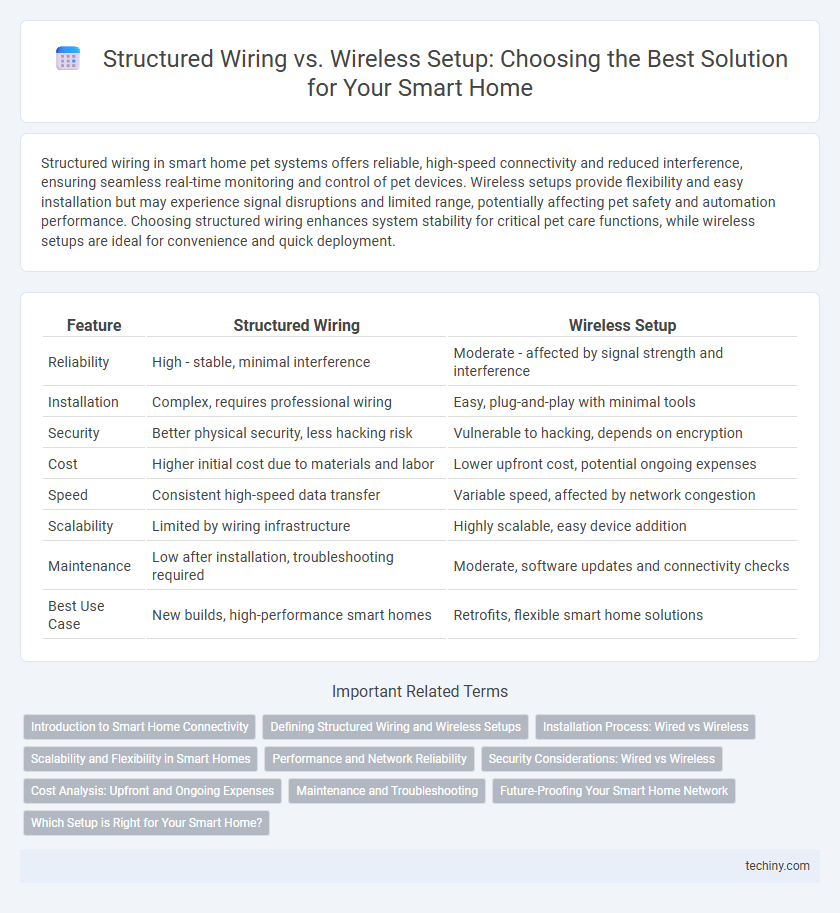Structured wiring in smart home pet systems offers reliable, high-speed connectivity and reduced interference, ensuring seamless real-time monitoring and control of pet devices. Wireless setups provide flexibility and easy installation but may experience signal disruptions and limited range, potentially affecting pet safety and automation performance. Choosing structured wiring enhances system stability for critical pet care functions, while wireless setups are ideal for convenience and quick deployment.
Table of Comparison
| Feature | Structured Wiring | Wireless Setup |
|---|---|---|
| Reliability | High - stable, minimal interference | Moderate - affected by signal strength and interference |
| Installation | Complex, requires professional wiring | Easy, plug-and-play with minimal tools |
| Security | Better physical security, less hacking risk | Vulnerable to hacking, depends on encryption |
| Cost | Higher initial cost due to materials and labor | Lower upfront cost, potential ongoing expenses |
| Speed | Consistent high-speed data transfer | Variable speed, affected by network congestion |
| Scalability | Limited by wiring infrastructure | Highly scalable, easy device addition |
| Maintenance | Low after installation, troubleshooting required | Moderate, software updates and connectivity checks |
| Best Use Case | New builds, high-performance smart homes | Retrofits, flexible smart home solutions |
Introduction to Smart Home Connectivity
Structured wiring offers reliable, high-speed connections by using physical cables like Ethernet or coaxial, ensuring consistent performance for smart home devices. Wireless setups provide flexibility and ease of installation through Wi-Fi or Zigbee networks but may face interference and coverage limitations. Choosing between structured wiring and wireless depends on factors such as home size, desired reliability, and specific smart device requirements.
Defining Structured Wiring and Wireless Setups
Structured wiring in smart homes involves a centralized network of cables, such as Ethernet and coaxial, installed throughout the property to provide reliable and high-speed connectivity for devices and systems. Wireless setups rely on Wi-Fi, Bluetooth, or Zigbee protocols, enabling flexible device placement without physical cabling but can be affected by interference and signal strength limitations. Choosing between structured wiring and wireless setups depends on priorities like installation complexity, scalability, and network stability.
Installation Process: Wired vs Wireless
Structured wiring involves running Ethernet cables, coaxial wires, and fiber optics through walls, offering high reliability and consistent speeds but requiring professional installation and significant labor. Wireless setups use Wi-Fi or Bluetooth technology, allowing easier installation and flexibility by avoiding complex cabling but may suffer from interference and limited range. Choosing between wired and wireless hinges on balancing installation complexity, network performance, and coverage needs in a smart home environment.
Scalability and Flexibility in Smart Homes
Structured wiring systems offer superior scalability by providing a dedicated, high-bandwidth network infrastructure that supports future smart home expansions and high data transfer needs with minimal interference. Wireless setups deliver enhanced flexibility, allowing easy device relocations and additions without the need for extensive cabling, although they may face limitations in bandwidth and signal stability as the number of connected devices increases. Choosing between structured wiring and wireless depends on prioritizing long-term network robustness versus immediate adaptability in smart home environments.
Performance and Network Reliability
Structured wiring offers superior performance and network reliability by providing dedicated, hardwired connections that reduce interference and signal loss compared to wireless setups. Wireless networks are prone to interruptions from physical obstacles and electromagnetic interference, impacting the consistency of smart home device communication. Hardwired systems also support higher bandwidths and lower latency, essential for bandwidth-intensive applications such as 4K streaming and home automation control.
Security Considerations: Wired vs Wireless
Structured wiring offers enhanced security by providing a direct, physical connection that is less susceptible to hacking and signal interception compared to wireless setups. Wireless smart home systems rely on radio frequency signals that can be targeted by cybercriminals through techniques such as packet sniffing or signal jamming. Choosing a wired setup minimizes vulnerabilities by reducing exposure to external threats and ensuring more reliable data transmission within the smart home network.
Cost Analysis: Upfront and Ongoing Expenses
Structured wiring systems require a higher initial investment due to the cost of cables, labor for installation, and professional setup fees, but they typically offer lower ongoing maintenance costs and increased reliability. Wireless setups have lower upfront expenses with easier installation and fewer materials but can incur higher long-term costs due to potential interference, regular updates, and possible replacement of wireless devices. Evaluating total cost of ownership includes considering energy consumption, scalability, and future-proofing capabilities of each option.
Maintenance and Troubleshooting
Structured wiring systems in smart homes offer centralized control and easier troubleshooting through dedicated wiring pathways and labeled connections, simplifying issue identification and repairs. Wireless setups, while flexible and quick to install, often require more frequent maintenance to address signal interference, firmware updates, and device connectivity problems. Choosing structured wiring reduces long-term maintenance complexities, ensuring stable and predictable smart home performance.
Future-Proofing Your Smart Home Network
Structured wiring provides a reliable and high-speed foundation for smart homes, supporting future upgrades like 8K streaming and advanced IoT devices without signal interference. Wireless setups offer convenience and flexibility but may face limitations in bandwidth and latency as device demands increase. Investing in structured wiring ensures a scalable, stable network capable of adapting to evolving smart home technologies.
Which Setup is Right for Your Smart Home?
A structured wiring system offers reliable, high-speed connectivity and reduces interference, making it ideal for large homes with extensive smart devices that demand stable network performance. Wireless setups provide flexibility and easier installation, suitable for smaller spaces or renters who require mobility without extensive modifications. Evaluating your home's size, device density, and future scalability will determine whether a wired or wireless smart home infrastructure best meets your connectivity needs.
Structured Wiring vs Wireless Setup Infographic

 techiny.com
techiny.com